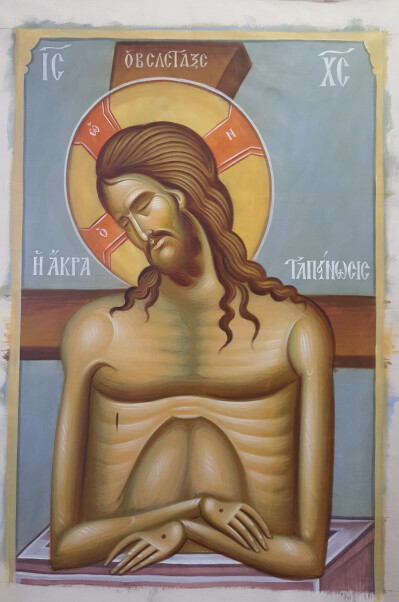Prothesis & Diakonikon Images
 |
 |
The sanctuary of a Byzantine/Orthodox church is adorned with many and various sacred images: those found on the icon-screen (iconostasis, templon), those that appear on the east wall (the apse and conch of the apse), on the side walls of the sanctuary, and on the arch over the sanctuary. However, in addition to these spaces where the icons are more visible to the faithful, there are two other significant liturgical spaces within the sanctuary proper, auxiliary chambers or niches, which flank the apse and customarily receive sacred images: the prothesis on the left or north side, and the diakonikon on the right or south side. Collectively, these auxiliary spaces were referred to as pastophoria and became standard from the 9th century onwards as part of the typical, centrally planned, domed church.
The term prothesis means “offering” and originally referred to the Bread and Wine that are offered and prepared for the Eucharistic service of the Divine Liturgy. By the 11th and 12th centuries, a completely separate and full liturgical rite developed for the preparation of the Eucharistic elements, referred to as the proskomide (offering or offertory) and liturgically the two terms eventually became synonymous. By association, the term prothesis was also applied to the niche or side apse on the north side of the sanctuary, since this is where the offering and the liturgical preparation (prothesis-proskomide) of the Bread and Wine (prothesis) takes place before the Divine Liturgy.
In the service of the proskomide, as the priest is cutting out the central portion of the Bread (Amnos-Lamb) to be used in the Liturgy, he recites verses from the Prophet Isaiah: 53: 7-8, referring to the spotless Lamb willingly led to slaughter and in particular verse 8: “in His humiliation judgment was denied Him.” Due to these verses from the proskomide, the image of Christ as the Extreme Humility (Akra Tapeinosis) became associated as the image par-excellence for the prothesis niche.
The image of the Extreme Humility (Akra Tapeinosis) developed as part of the late 11th-century Passion imagery, becoming not only the image associated with the services of Holy Friday, but also closely identified as the image most appropriate for the prothesis. Some examples: in the 13th-century frescoes of the Omorphokkesia (Saint George) in the suburbs of Athens; in the 15th-century church of Panagia Kapetanianon, Crete; in the 16th-century church of Saint Nicholas Philanthropinos, Ioannina; and in the 16th-century church of Stavronikita, Mount Athos, also dedicated to Saint Nicholas. This iconographic tradition continues into our own day.
The image of Christ as the Extreme Humility expresses profound theological concepts. The Lord is depicted half-length, arms folded before Him, dead but upright in His tomb, and before the Cross. The identification as Extreme Humility, or in Greek, Akra Tapeinosos (from Isaiah 53:8), refers to Christ’s extreme humility of voluntary death in the flesh. In the West the image became known as the Man of Sorrows, also a reference to Isaiah 53:3, a Man of suffering. In the icon, Christ is seen as both God and Man. His body retains its sinless beauty and upright living position, yet He is dead in His Humanity, with His eyes closed, His head tilted and His body bearing the marks of the lance and nails. The title on the Cross is always “The King of Glory” (o Basileus tes Doxes), referring to Psalm 23:7, the Lord as the King of Glory, and to I Corinthians 2:8, when Saint Paul proclaims: “they crucified the Lord of Glory.” In death the Lord is still triumphant because of His Resurrection as God. Although He suffers the extreme humiliation of death, He is still the King of Glory of the Resurrection.
In the flanking niche, to the right or south of the altar, is the diakonikon. The term refers to the sacristy where sacred vessels were kept and thus used by the deacons, hence the term’s derivation. Historically, a variety of images have been employed to adorn the diakonikon, all associated with Eucharistic/sacrificial themes: such as the Sacrifice of Isaac; the Old Testament Righteous Melchisedek, the King/Priest of Salem (Genesis 14) who brought bread and wine to Abraham; the Hospitality of Abraham (the Three Angels); or Saint John the Baptist-the Forerunner (Prodromos), as seen in the church of Stavronikita Monastery. In such examples, Saint John holds a scroll with the text, “Behold the Lamb of God” (Ide, o Amnos tou Theou), from John 1:29, when the Baptist first encounters Christ and proclaims, “Behold the Lamb of God who takes away the sin of the world.”
Such an example serves as a model for that appearing in the diakonikon of the Shrine of Saint Nicholas. The text of the Prodromos’ scroll directly relates across the sacred space of the sanctuary to that of the prothesis, where the Bread is prepared and dedicated to become the Lamb of God of the Eucharist, for the Bloodless Sacrifice of the Liturgy. The corresponding prothesis image of the Extreme Humility (Akra Tapeinosis) responds antiphonally, by revealing Christ’s dual nature - His Divinity and Humanity, the Incarnate Lamb of God that we receive and participate in at every Communion, which opens the path for our own salvation.